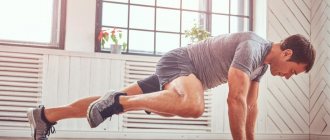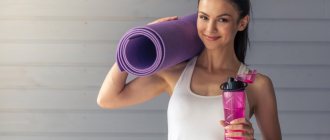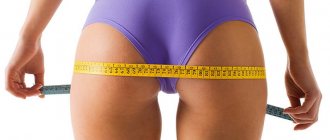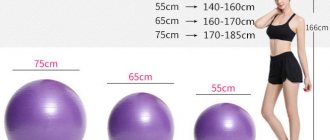Almost every woman dreams of making her figure ideal, using all sorts of methods. It turns out that you can lose extra pounds and get in good shape with the help of a Swiss ball - a fitball. A whole set of exercises has been developed for working with such a simulator. We'll look at it in more detail in the article.
What are the benefits of exercising on a fitball?
The Swiss ball - fitball - began to be used in practice by physiotherapists starting in the 50s. It was used for patients with spinal injuries, paralysis and cerebral palsy. Twenty years later, athletes, coaches, and aerobics leaders became interested in it. And today, exercise with fitball is a separate progressive direction in sports. The thing is that when working with a fitball, all the muscles of our body begin to work.
The benefit of exercise is to normalize all areas of the figure. Improves posture and body flexibility. Muscles and ligaments become more elastic. The nervous system comes into order, blood circulation improves, the vestibular apparatus is strengthened. Coordination of movements has positive dynamics.
Fitball exercises are widely used in training in fitness clubs. A person who does aerobics with a ball for two months becomes more toned and his back straightens. Extra pounds disappear proportionally from the entire body. Over time, the figure takes on its ideal shape.
Despite the fact that when working with a fitball, all muscles are occupied, the load on the lower limbs is minimal. Therefore, elderly people, children and expectant mothers will be able to train with the ball.
Exercises with a fitball give good results if you choose the right ball.
How to exercise correctly on a fitness ball
Fitball exercises for weight loss have a number of important features that are important to consider:
1. Focus as much as possible on muscle mass, feel every muscle in your body. You shouldn’t chase speed and do everything quickly; it’s better to focus on quality.
2. Don't focus on one problem area. The complex should contain loads on the entire body and work out all muscle groups. If you are trying to lose weight, then working only on your abs or buttocks will not give the desired result.
3. The more you inflate the gym ball, the more effort you will need to exert during the workout. If you are just starting to train with this equipment, it is better to avoid high elasticity.
4. If you want to develop your own training system, use the circuit principle. Choose 5-10 exercises from the ones above and alternate them, performing several rounds.
5. If you are a beginner, during your first workout you should not try to catch up on all the missed sessions and take on all the exercises at once. Master a few, practice them to high accuracy, then move on to the next group. If you experience difficulty at the very beginning when performing, modify the workout by switching to a simpler option.
How to choose the right fitball by size and shape
When choosing a projectile, you should pay attention to the density of the material. It should be elastic, odorless and with barely noticeable seams. If the seller allows you to “try on” the fitball on yourself, do not neglect this opportunity. In the “sitting” position, the angle between the thigh and torso should be at least 90 degrees, so the load on the limbs will be small.
The main parameter when choosing a simulator is a person’s height. The diameter of the ball in relation to this indicator should be approximately three times smaller. Using the data from the table below, you can easily select a fitball according to your parameters:
If you are a beginner athlete, then a small ball will do for the first stage of training. As you gain experience, you can purchase a larger size fitball.
You can also select a simulator based on your outstretched arm, the length of which from the shoulder joint to the fingertips will correspond to a certain diameter of the ball. Details in the table:
As you can see, the diametric size of the ball is almost equal to the length of the limb.
When purchasing a fitball, you need to consider for what purpose you are buying it. For children and pregnant women, a ball with “ears” is suitable; for patients with musculoskeletal problems, a “ball with spikes” with a massage effect is suitable; for sports, a regular round elastic exercise machine is suitable.
Choose a fitball that can support up to 300 kg. This simulator will last for a long time.
Choosing a gymnastic ball
There is an opinion that the size of a gymnastic ball should be selected in accordance with a person’s height. Of course, this theory has its advantages, since during pregnancy it is necessary to create the most comfortable conditions for exercise. But on the other hand, if the exercises are performed by an ordinary person (i.e. not pregnant), then the size of the ball does not play a special role. Of course, if you choose a very small fitball, it will be quite difficult to maintain balance during exercise.
Choosing the right fitball
Among the variety of balls, the diameter of which ranges from 45 to 90 cm, you need to choose the most suitable one. When choosing, you should follow the recommendations of experts. To do this, sit on the ball and try to bend your knees 90°. If you manage to do this and the resulting angle is approximately 90°, then the ball fits.
Warm up with fitball
Working with a gymnastic ball requires a lot of physical effort. After the first workouts, the muscles hurt a little until they get used to it. Before starting serious exercise, you need to do a warm-up. This will warm up the body and relax the muscles. Let's do a series of simple steps:
- Open steps in different directions. We don't use the fitball yet.
- We hold the ball with outstretched arms and move with side steps to the left and right thirty times.
- We perform the same additional steps with the removal of the projectile in the direction of walking.
- We put the ball aside. We do hip raises up to sixty times.
- Run in place for two minutes.
- We hold the fitball with outstretched arms and lift it from the waist level upward, the ball above the head. At the same time, we perform a step in place.
- We hold the apparatus in front of us and squat up to twenty times.
After warming up, you can begin the main exercises.
Indications
People of different genders and ages can use fitball, since it is a universal gymnastic tool. As a rule, physical therapy is prescribed to pregnant women to relieve stress on the spine and joints, which women often face while carrying a child.
The fitball ball is a gymnastic orthopedic ball with a diameter of 45 to 95 cm depending on height
As a preventive measure for various diseases, as well as for developing correct posture, exercises with a gymnastic ball are often prescribed to young children over 5 years old . Studies have shown that children who regularly play sports, in particular on fitball, are less likely to experience disorders in the nervous, respiratory and cardiovascular systems. In addition, their body is accustomed to regular physical activity, so overstrain in muscle tissue does not occur. As an effective method of combating arthritis, a gymnastic ball is prescribed to older people . Regular exercises restore full movement of their body.
Fitball with horns
There are other pathologies for which patients are prescribed exercises with a fitball. The most common ones include:
- poor posture;
- osteochondrosis of the transverse section;
- curvature of the pelvis (oblique position);
- development of flat feet (transverse or longitudinal);
- curvature of the back or, as doctors also call it, scoliosis.
Fitball during pregnancy
All of the above violations serve as an indication for the use of a special gymnastic ball. Of course, all exercises, the duration of the therapeutic course and additional procedures in the treatment of a particular disease should be prescribed by a doctor.
A set of exercises for weight loss
With the help of weight loss techniques using the Swiss ball, you will not only get rid of excess weight, but also gain proportional good shape of your body. We will practice on the floor. For convenience, you can purchase a fitness mat. We will start the exercises from the waist.
We work on the press while lying down, holding the ball in front of us with outstretched arms. In this position, without lifting yourself off the floor, raise your legs vertically. At the highest point, we spread our legs apart. At first, do this exercise no more than ten times so as not to overload your muscles.
There are other effective abdominal exercises.
Then we begin to strengthen the muscles of the thighs and buttocks. Lying on the floor, place your feet on the exercise machine. We begin to lift our back and butt at the same time, without taking our feet off the ball.
You can find additional exercises for the buttocks here.
our arms stronger . We lie down face down, raise our knees onto the apparatus and begin regular push-ups from the floor. This action will allow the muscles of the arms, legs, hips and abdomen to work simultaneously.
These are the basic exercises for weight loss. There are actually a lot of them. For yourself, you need to choose those that put stress on problem areas. Weight decreases noticeably if you exercise constantly and do not neglect proper nutrition.
Ball training for beginners: balance, strength, coordination
We may not think too much about a sense of balance and stability, but these elements are very important to everything we do, from daily chores to sports.
Think about it: Each joint is made up of ligaments and tendons connected to all the muscles that keep your body in the correct upright position. The more you can strengthen your connective tissue and stabilizing muscles, the better your entire body will be, no matter what you do.
The great thing about balance and stability training is that you don't have to do complex or intense exercises. In fact, one simple tool, the exercise ball, can help you work on all of this through a variety of simple, easy-to-do exercises.
The following exercises allow you to work all areas of the body, but are also ideal for beginners due to their versatility. If you've never used an exercise ball before, try sitting next to a wall or, if necessary, hold on to a chair. And only then continue to perform the exercises without any support.
Precautionary measures
Consult your physician if you have any injury or illness.
Necessary equipment
Exercise ball.
How to train correctly:
- Use the first exercise to warm up your body and prepare it for exercise.
- Perform each exercise for up to 3 sets. If you are a beginner, start with 1 set and gradually increase the amount over time.
- Hold onto a wall for balance if you need to, and use a sticky mat or shoes with good traction to avoid slipping.
- Skip any exercise that causes pain or discomfort.
Circular movements on a fitball
This is an ideal exercise to relax and get used to sitting on the ball. Make the circles small or large, it all depends on your preference. Once warmed up, you can deepen each circle.
- Sit on the ball and place your hands behind your head (an element that makes the exercise more difficult), on the ball, or hold on to a wall if you need more stability.
- Slowly begin moving your hips in a circle to the right, arching slightly as your pelvis moves back.
- Tighten your abs as you move forward.
- Repeat 20 circles to the right, then to the left.
March on fitball
This exercise is a great way to practice balance by lifting one foot off the floor and forcing your standing leg to remain stable. You can also hold on to the wall here if you need to.
- Sit on the ball with your spine straight and your abs tense.
- Place your hands behind your head (an element that makes the exercise more difficult) or keep them on a ball and lift your right leg a few centimeters off the ground.
- Lower your leg and raise your left leg the same distance.
- Continue by alternating between lifting your right and left legs.
- Once you get the hang of it, lift your legs higher and speed up the pace.
- You can also add jumping jacks if you feel comfortable.
- Repeat for 1-2 minutes.
Exercises for losing belly fat on a fitball
A flat tummy is every lady's dream. It’s not enough to get rid of extra pounds, you also need to remove cellulite.
A fitball will help us. There are a lot of exercises, let’s look at the main ones:
- First of all, we work on the abs. We lie down on the floor, fix the ball between our ankles, begin to lift the projectile up, bend our legs and pull it towards us together with the fitball. We perform up to 12 times at the beginning of training, then increase the load.
- In the “lying down” position, hold the projectile between your feet. Raise the machine up without bending your legs.
- Let's pump up the press. Hands are behind the head, feet on the ball, knees bent. We lift our heads off the floor up to twelve times.
- Put your elbows on the ball, stretch your body to the limit, toes touch the floor. In this situation you need to hold out to the limit of your capabilities.
- We lie down on the fitball, resting our hips against it. We place our hands on the floor so as not to fall. We raise our legs from the floor to a horizontal position, pulling them up as far as our posture allows.
- We sit on the ball and begin rolling so that our back is on the apparatus, inhale - hands behind the head, exhale - raise our head, shoulders and shoulder blades until the back muscles are strongly tense. In this position, we freeze for a few seconds and lower ourselves.
- We lie down on the fitball with our backs and make a bridge. Palms and feet are on the floor. Try to roll the projectile from your hips to your feet, hold for a second and return to the starting position.
- We sit astride the apparatus, our back is straight, our feet are pressed to the floor. We roll from side to side up to fifty times.
In the first days, do all exercises, except the last one, 10-12 times. Every day you can add 1-2 times, and bring up to 120 times.
Back care tips
If you have once encountered pain in your back, this should serve as some kind of signal for you to change your lifestyle. It is necessary to get rid of bad habits that negatively affect the body, in particular the lower back. You should start by following basic rules that will help change your life for the better.
Back pain is a reason to reconsider your lifestyle
Prevention of back pain, first of all, involves the following recommendations:
- you need to lift all the weights correctly - first sit down yourself, and then, firmly grasping the object, straighten your legs and stand with it. This rule applies to all types of weights;
- if you need to carry something heavy in bags, then try to distribute the weight evenly among the bags . With an equal distribution of weight on both hands, the likelihood of injuring your back is reduced;
- When washing your hair in the bathroom on straight legs, bending over is strictly not recommended . First, bend your knees slightly and then bend over;
- Try to always sleep on a hard mattress .
This will provide the spine with proper rest at night, since it has been in a tense state throughout the day; Optimal mattress firmness - while walking, your back should be straight . If you don’t notice any mistakes in yourself, then ask your loved ones or friends to watch you. Your back should be straight not only while walking, but even when you are sitting or standing;
- If you lead a sedentary lifestyle, then try to make time for regular exercise . It is enough to engage in any sport several times a week, be it swimming, running or the gym. If you have the opportunity to exercise on a fitball, that’s good, because such activities are great for preventing neck or back pain.
Rules for maintaining correct posture
Back pillow
There are certain situations in which sports are contraindicated, even for preventive purposes. First of all, we are talking about serious problems with the spine or severe pain in the lumbar region . It is also not recommended to do any exercise after recent surgery. But your attending physician will definitely inform you about this.
Exercises for losing weight on thighs and buttocks
When working on the hips and buttocks using exercises with a fitball, the muscles of the abs, back, arms and legs are included in the work. Almost the entire body is involved.
We begin strengthening the muscles of the buttocks by kneeling and moving the ball towards us from the side on the right side. We raise our left leg vertically, hold it a little, then bend it, bring it towards the ball and again move our leg to the side, up to 12 times. We will do the same on the other side, extending the right leg. At the same time, the oblique abdominal muscles work.
Now let’s lie with our stomach on the ball, put our hands on the floor, raise our right leg up to the stop up to 12 times, then, by analogy, our left leg. Let's strengthen the lower back.
Let's turn our back to the fitball, throw our right foot back on it, keep our back straight. We begin to bend towards the left foot, with our arms raised up. Let's do the action 12 times and change the position to the other side. Works the buttocks and back of the thighs.
Place your palms in the “lock”, rest your forearms on the projectile, alternately raise your left and right legs 12 times upward for as much as you can endure. Here, the buttocks, abs, lower back and back of the thighs are simultaneously strengthened.
The same exercise can be done in a similar way, resting on the ball with outstretched arms. Strengthens your back.
We will do the abdominal exercise with our arms bent. Let's rest our forearms on the projectile. We bend our legs one by one, touching the ball.
We will simultaneously work the oblique muscles of the abdomen and thighs in a “lying down” position. Place your hands on the back of your head, spread your elbows to the side, and hold the fitball between your feet. Our task is to bring the right knee to the left elbow, and by analogy, on the other side.
We lie on the ball with our backs, bending our knees. We stretch our arms above our heads and make movements as if we were climbing a rope. Let's strengthen the oblique abdominal muscles.
The main exercise to strengthen the chest is push-ups. We take a horizontal position, throw our legs onto the ball. We begin to lower ourselves down to the limit on our hands. First, we will focus on the fitball with our hips. Over time we move on to the ankles.
We strengthen our arms using a fitball and dumbbells. We lie on the ball with our backs at an angle of 45 degrees, with our knees bent. We take dumbbells and raise our arms up and down. Do not lower too much to avoid stretching the ligaments.
We will do the same exercise in a vertical position above the floor. We lie down on the ball with our backs, rest our feet on the floor, stretch our arms with dumbbells in front of us, then slowly bend them towards our shoulders and back to the starting position.
Increase the load gradually. Take into account childhood musculoskeletal injuries. Consult with a trainer before starting classes.
Training plan
If you want to achieve the maximum result from the training process, it is better to create an individual program taking into account your personal characteristics, goals and objectives. You can use and combine the above exercises. Take turns shifting your focus from one area to another.
In general, a ball session should consist of three main blocks:
1. Warm up. For warming up, it is better to use a traditional complex, which is universal regardless of the equipment used. Rotational movements and swings are used as a base; the duration of execution is 4-5 minutes. It is necessary to move from one area to another smoothly, carefully working and preparing each muscle group.
2. Exercises with a fitball. This is the main block. You can perform it using a ready-made program, which is presented in the table. Everyone determines the frequency of exercise for themselves - it would be optimal to exercise 2-3 times a week so that the muscles have time to rest.
| № | Exercise | Repeats per set | Approaches |
| 1 | Squats with raised arms | 20 | 3 |
| 2 | Wall Squats | 20 | 3 |
| 3 | Pelvic lift | 20 | 3 |
| 4 | Bulgarian lunges | 20 per leg | 3 per leg |
| 5 | Hyperextension (regular or reverse) | 20 | 1 |
| 6 | Push-ups (regular or reverse) | 10 | 3 |
| 7 | Plank | 30 sec – 1 min | 3 |
| 8 | Reverse twists | 15 | 3 |
| 9 | Spire | 20 | 1 |
| 10 | Book | 20 | 1 |
| 11 | Knees to chest | 20 | 1 |
| 12 | Reverse roll | 10 | 1 |
| 13 | Side lunges | 10 | 1 |
Stretching. Experts recommend not to ignore stretching, as it allows you to relieve stress from muscle mass and relieve stress on the spine.
Useful training tips
If you decide to go in for sports, lose a couple of extra pounds, fitball is suitable for everyone, without exception. In addition to strengthening the muscles of the whole body, you will gain additional energy, lightness and good mood. Basic training tips:
- Choose the ball correctly according to your parameters. It is better to purchase it in person at the store. Jump on it if allowed. It is more advisable to buy a fitball at a sports store.
- Proper nutrition. There will be no good effect from exercise if you overeat. You can replenish the energy lost after training with boiled meat, salad with olive oil, and vegetable juice.
- Don't overload yourself right away. Start doing several exercises a day on the most problematic areas. Once the muscles get used to the load, you can increase the number of exercises. Do not forget that you need to study little by little, but constantly, without skipping.
- With age, bones become brittle. To avoid injuries and sprains, undergo a short examination and consult with a fitness trainer.
Follow the advice, and the results will not keep you waiting.
Today a gymnastic ball can be found in any store for both children and adults. But not everyone knows the true purpose of sports equipment. Using such a simple exercise machine at home will allow you to get in good shape in a short time, strengthen or improve your health, and save personal time and family budget.
Ideal ball size
To get the most out of your exercise ball training program, you need to make sure you choose the right exercise ball. Later in the article we will tell you which ball is suitable for whom.
As with other workouts, repetitions and sets play a big role in achieving your fitness goals. And, as a rule, in order to correctly master the technique, you need to be a little boring and learn the theory about the exercises.
The exercise poster contains the 35 best exercises you can do on the ball. This will provide you with training options for life. Simply hang an exercise poster in your gym and use it as a workout guide to increase exercise variation.
Benefits for the buttocks
Exercises with this sports equipment, according to most trainers, mainly strengthen the stabilizer muscles. In regular training without the use of equipment, they are little involved. It is these muscles that are poorly worked in other exercises. Fitball is especially useful for people after injuries and women in the postpartum period. Many people after childbirth are interested in the question: how to pump up your butt if many strength exercises cannot yet be performed. Easy and effective ball exercises will help women with this. The fitball is useful for both the butt and the hips. The figure after regular exercise becomes fit and attractive. Even just sitting on a fitball loads your muscles, and calories are burned due to balancing.
If you want to lose weight and pump up problem areas, a gymnastic ball is the best assistant in this.
Benefits from classes:
- strengthening muscles;
- development of good coordination;
- improved plasticity;
- relieving tension in the back area;
- improved posture;
- weight loss;
- giving beautiful relief shapes to the gluteal area.
Another great advantage of the Swiss ball (another name for fitball) is that you can exercise with it both in the gym and at home.
One of the advantages of a fitball is the ability to perform familiar exercises from non-standard positions.











